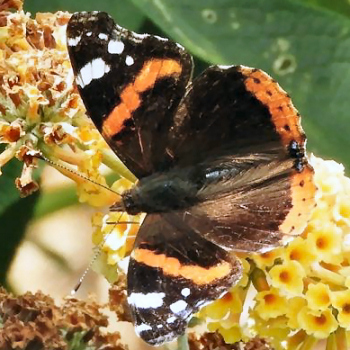|
Sightings between February and September 2019 in Winsham parish; not just
in our gardens but on walks, too!
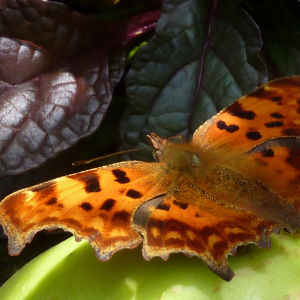 |
Comma
Polygonia c-album
Our only butterfly with deeply scalloped wing margins; with its
wings closed this looks like a dead leaf, but when open it is a
spectacular black-speckled orange. The food plant is Common Stinging-nettle.
Observed
in Winsham on February 27th,
and again in July and August. Not all that common, but can still
be seen regularly.
|
| |
Orange-tip -
Anthocharis cardamines -
no picture
The herald of spring! The males have bright orange tips to their
wings and are unmistakable, the females looks a bit like the
Whites, but has a handsome green/white mottling on the
underside. Food-plants are Cuckooflower or Jack-by-the-hedge.
First
seen in Winsham on April 6th
this year, with more in later April and May.
|
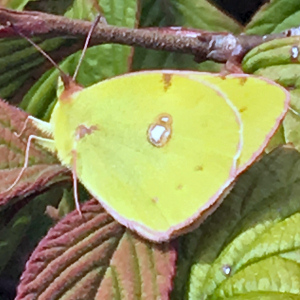 |
Clouded Yellow
Colias croceus
A migrant from North Africa and Southern Europe, common in some
years, rare in others Very distinctive in flight, with its
bright yellow wings. Food plants are leguminous plants such as
clover, lucerne and birds foot trefoil.
In Winsham seen a few times in early September.
|
|
Marbled White
Melanargia galathea -
no picture
Very distinctive with its black-and-white marbling on the open
wings; and with a slow, flapping flight. Has a short summer
flight period; food plants are fine grasses.
In Winsham seen only once this year, on
July 16th.
|
|
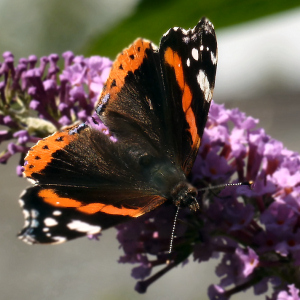
|
Red Admiral
Vanessa atalanta
One of our commonest species, from late May to November but
these are immigrants from the European continent. The food plant
is the common Stinging nettle, and the early arrivals produce
the second generation we see in summer and autumn. They love
Butterfly bushes (Buddleia) and fallen apples.
Seen in Winsham on March 26th,
and every month since to August (so far).
|
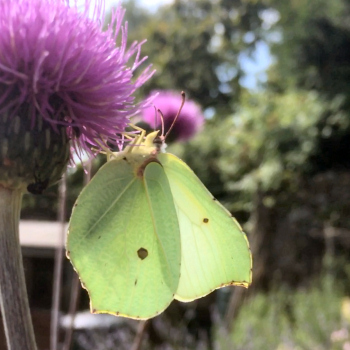 |
Brimstone
Gonepteryx rhamni
The butterfly that gave butterflies their name: the males are
butter-coloured. Females are much paler, almost greenish white.
A long-lived species, which can be seen in most months. Food
plants are Buckthorn or Alder buckthorn.
First seen in Winsham on February 26th,
seen every month since then so far.
|
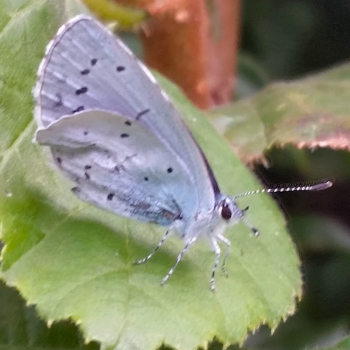 |
Holly Blue
Celastrina argiolus
Widespread and common, but not easy to distinguish from the
Common Blue; the giveaway is that the Common Blue has orange
spots on the underside of the wing, and the Holly Blue only
black ones. The food plants are Holly (for the spring brood) and
Ivy (for the summer brood).
First seen on April 19th,
with more in May, and the occasional second-generation one in
July.
This picture was taken by Roger
Lawrence in Lime Kiln Lane on the 5th August.
|
|
Large White
Pieris brassicae-no picture
Gardeners call this the Cabbage White, and that is one of the
favourite food plants of this species; they love Brussels
sprouts as well. Can be confused with the Small White, but the
Large has more black on the wingtips. The caterpillar is well
known to gardeners: green/black spotted, with long yellow
stripes all along the body. First seen on
April 19th, with more in
May and July.
|
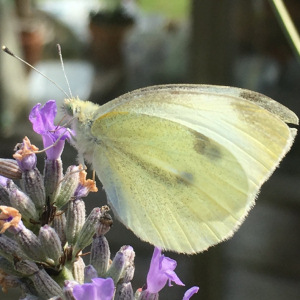 |
Small White
Pieris rapae
Smaller than the Large White, and just about as common. This
comes in two generations, a spring one and a summer one; food
plants are Cabbage, Sprouts and Nasturtiums.
In Winsham, first seen on March 29th,
with more in every month since (so far). One of our common
butterflies.
|
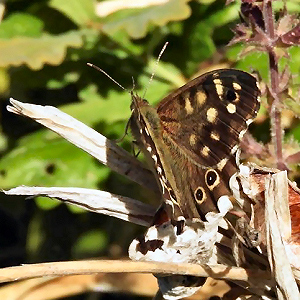 |
Speckled Wood
Pararge aegeria
Easy to identify, as no other butterfly has these cream or
yellow markings on chocolate-brown wings. They mostly sip
honeydew, a sticky liquid produced by aphids and scale insects
high up in trees; but will come down to feed on flowers, or to
bask in the sun. Eggs are laid on various grasses.
In Winsham first seen on April 21st,
with more in May, and later in July.
|
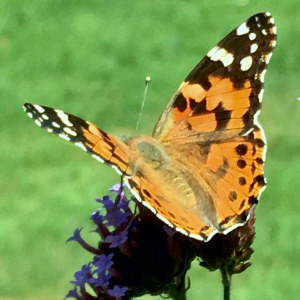 |
Painted Lady
Vanessa cardui
A beautiful immigrant that can be rare or absent for several
years at a stretch, but is common in some years, including in
2019! Ours come from North Africa in a series of steps: some of
ours (the faded ones) are probably straight from Africa, but the
fresher ones come from their breeding on the way or even from
England itself. In autumn returning migrants have been detected
at altitudes of up to 500 metres. The food plant is Thistle.
In Winsham, first seen on June 1st, then none until
August.
|
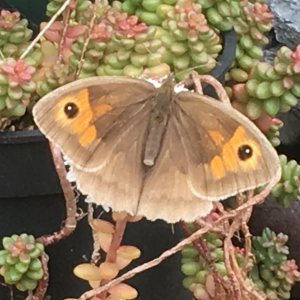 |
Meadow Brown
Maniola jurtina
Very common around our area, and can only be confused with the
Gatekeeper (which has more orange on its wings, and two white
dots in its wing roundel). It usually flies close to the ground,
and its food plants are grasses.
In Winsham first seen on June 15th, and in every
month since (so far).
|
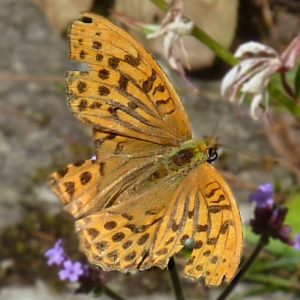 |
Silver-washed Fritillary
Argynnis paphia
A butterfly of woodland, whose caterpillars feed only on Common
Dog-violets. Not seen every year.
In 2019 it was seen on July 4th,
and only once or twice since.
|
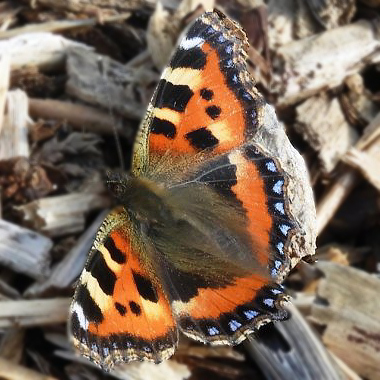 |
Small Tortoiseshell
Aglais urticae
Easily identified by the blue-on-black spots along the
wingsides. Can be seen in almost any month, though not always
outside: they hibernate in sheds and attics! Their food plant is
the Common Stinging-nettle.
First seen on March 25th
(apart from one in an attic in January), with only a few more in
April and July;
suddenly re-appearing in numbers in early September!
|
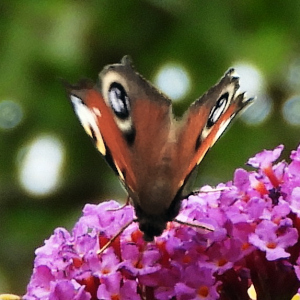 |
Peacock
Aglais io
Handsome and unmistakable with its large eyes or wing
roundels; and almost black undersides of wings. They will flick
their wings at potential enemies, scaring them off with those
sudden flashes of their eyes. Their food plants are the Common
Stinging-nettle.
In Winsham first seen on March 24th,
with more sightings in every month (so far). One of our common
butterflies.
|
|
Small Copper
Lycaena phlaeas-no picture
A spectacular black-and-orange colour, this is pretty
unmistakable. The males are very territorial and will attack any
insect coming on their patch. Food plants are Sorrel.
Seen only once this year, on July 20th.
|
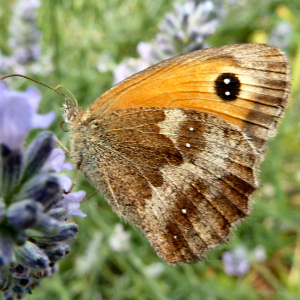 |
Gatekeeper
Pyronia tithonus
A small and common species, mostly orange with a darker edge to
the wing, and two small white spots in its wing roundel. Food
plants are fine-leaved grasses. Also called Hedge Brown: this
likes to be by brambly hedgerows, and can often be seen by our
cemetery.
First
seen on July 10th,
and from then on very common to the end of August.
|
|
Small Skipper
Thymelicus sylvestris-no picture
Very bright orange species could be mistaken for a moth, but the
club-end antennae make this a proper butterfly. A real summer
species; the food plant is Yorkshire Fog, a common grass.
Seen only
once this year, on July 28th.
|
The
purpose of this diary is to
provide a record for the Winsham Web Museum for the interest of the residents of
Winsham, and future generations. This record may prove useful information, for comparison purposes, in the context of global warming and
changing patterns of agriculture.
|

